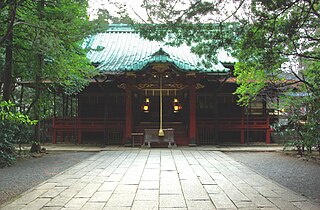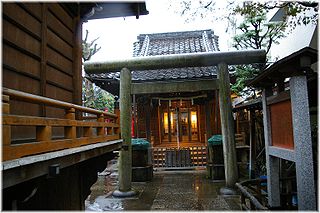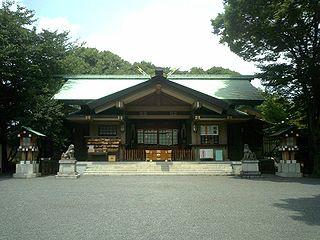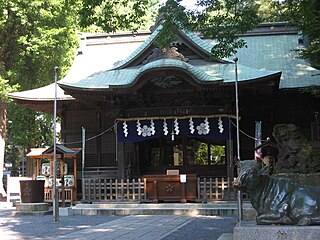 W
WAsakusa Shrine is a Shinto shrine located in the Asakusa district of Tokyo, Japan.
 W
WThe Atago Shrine in Minato, Tokyo, Japan is a Shinto shrine established in 1603 on the order of shōgun Tokugawa Ieyasu. The current shrine buildings on the site date from 1958.
 W
WChinreisha is a small wooden Shinto shrine located directly south of Yasukuni Shrine's honden in Yasukuni Shrine precinct. It was built in 1965 after a proposition by Yasukuni's main priest, Fujimaro Tsukuba and has an annual festival held on July 13. In 1975, a steel fence was erected around the shrine and it was closed off to the public. This came after an incident on Hokkaidō a year earlier where a shrine was set on fire and after the chief priest at Yasukuni had received intelligence that unknown persons were planning to destroy the Chinreisha. It was re-opened for worshipers on October 12, 2006, to spread the spirit of cherishing allies and enemies alike and remembering all the war dead around the world.
 W
WThe Hanazono Shrine is a Shinto shrine located in Shinjuku, Tokyo, Japan. This shrine was founded in the mid-17th century. Hanazono Jinja nestled in the heart of Tokyo's Shinjuku ward, Hanazono Jinja is a small and unobtrusive structure that, according to Fodor's, just happens to be one of the most historical shrines in Japan. Constructed in the Edo period by the Hanazono family, this Inari shrine—a shrine dedicated to Inari, the androgynous god of fertility and worldly success—is a favorite place for businessmen to pray for successful ventures.
 W
WThe Hie Shrine is a Shinto shrine in Nagatachō, Chiyoda, Tokyo, Japan. Its June 15 Sannō Matsuri is one of the three great Japanese festivals of Edo. Other names for the shrine include Hiyoshi Sannō-sha, Hiyoshi Sannō Daigongen-sha, Edo Sannō Daigongen, Kōjimachi Sannō, Sannō-sha, and Sannō-sama.
 W
WHikawa Shrine is a Shinto shrine in Akasaka, Tokyo, Japan. In Tokyo, it is the best known of the 59 branch shrines of the Hikawa jinja, which was designated as the chief Shinto shrine (ichinomiya) for the former Musashi province.
 W
WKameido Tenjin Shrine is a Japanese Tenman-gu shrine located in Kameido, Koto Ward, Tokyo. The shrine is dedicated to Sugawara no Michizane, a 9th-century Japanese scholar.
 W
WKanda Shrine , is a Shinto shrine located in Chiyoda, Tokyo, Japan. The shrine dates back 1,270 years, but the current structure was rebuilt several times due to fire and earthquakes. It is situated in one of the most expensive estate areas of Tokyo. Kanda Shrine was an important shrine to both the warrior class and citizens of Japan, especially during the Edo period, when shōgun Tokugawa Ieyasu paid his respects at Kanda Shrine. Due in part to the proximity of the Kanda Shrine to Akihabara, the shrine has become a mecca for technophiles who frequent Akihabara.
 W
WKarasumori Shrine is a Shinto shrine located in Minato, Tokyo. It enshrines Ukanomitama, Ame-no-Uzume and Ninigi-no-Mikoto.
 W
WKasai shrine was the head shrine of eleven towns in the region and is classified historically as a "Gousha". It is located in Higashi Kanamachi, Katsushika district, Tokyo.
 W
WKume no Heinai-dō (久米平内堂) is a small folk shrine located in Asakusa in Taitō, Tokyo. The shrine houses a stone statue of Kume no Heinai, a samurai from the early Edo period. According to the Asakusa tourism bureau, there are few facts about the life of Kume no Heinai, but he is said to have died in 1683. Oral tradition holds that Heinai excelled in Kenjutsu, the martial art of swordsmanship, killing many people over the years. In the latter half of his life, he is said to have lived in the Sensō-ji temple in Asakusa where he devoted himself to Zen-Buddhism and held religious services in honor of the people he killed. Shortly before his death he ordered his followers to carve his likeness on a stone and bury it near the Niōmon – the entrance to the Buddhist temple and a busy district in the city. His wish was to have his statue be stepped on by as many people as possible in order to expiate the crimes he committed in life. The statue was eventually retrieved and is now stored inside the shrine itself. It is because of this that the shrine initially carried the name Fumitsuke (踏みつけ), which means "to tread on", but over time the meaning was lost and the shrine's name came to be spelled 文付け, which means "love letter". Both words are pronounced Fumitsuke and the shrine is now worshipped by the general public as a deity of marriage and match-making. Kume no Heinai-dō was destroyed in March 1945 during World War II. The current temple was rebuilt in October 1978.
 W
WMaruyama Shrine (丸山神社) is a Shinto shrine in Takanawa, Minato, Tokyo, Japan. The shrine was established in 1179.
 W
WMeiji Shrine , is a Shinto shrine in Shibuya, Tokyo, that is dedicated to the deified spirits of Emperor Meiji and his wife, Empress Shōken. The shrine does not contain the emperor's grave, which is located at Fushimi-momoyama, south of Kyoto.
 W
WMita Hachiman Jinja (御田八幡神社) is a Shinto shrine in Mita 3-7-16, Minato, Tokyo, Japan. Its festival is on 15 August.God's Name: Hondawakeno Mikoto (誉田別尊命), Amenokoyaneno Mikoto (天児屋根命), Takenouchi Sukuneno Mikoto (武内宿禰命) Shrines in precincts: Gokō Inari Jinja (五光稲荷神社), Mikage Jinja (御嶽神社) Facilities in precincts: Kaguraden, Chōzuya, Shamusho.
 W
WNezu Shrine is a Shinto shrine located in the Bunkyō ward of Tokyo, Japan.
 W
WNogi Shrine was established on November 1, 1923 and dedicated to General Nogi Maresuke (63) and his wife Nogi Shizuko (53) after their death on September 13, 1912. The Tokyo Mayor, Baron Yoshio Sakatani, took the initiative to organise the Chūō Nogi Kai to build a shrine to the couple within their residence. It is located in Tokyo, Japan.
 W
WOji Shrine is a Shinto shrine located in the Kita-ku ward of Tokyo, Japan.
 W
WŌkunitama Shrine is a shrine located in Fuchū, Tokyo, Japan. Six shrines in Musashi province were consolidated and their gods enshrined there. Ōkunitama is now known as one of the five major shrines in Tokyo, the others being the Tokyo Great Shrine, Yasukuni Shrine, Hie Shrine and Meiji Shrine.
 W
WŌmiya Hachiman Shrine is a Shinto shrine located in Suginami, Tokyo, Japan. It is a Hachiman shrine, dedicated to the kami Hachiman. It was established in 1063. Its main festival is held annually on September 15. Kami enshrined here include Emperor Ōjin, Empress Jingū and Emperor Chūai in addition to Hachiman.
 W
WShiba Tōshō-gū (芝東照宮) is a Tōshō-gū Shinto shrine located in the Minato ward of Tokyo, Japan.
 W
WShōin Shrine , located in Setagaya, Tokyo, is the Shinto shrine that is dedicated to the deified spirit of Yoshida Shōin, an activist during the Edo era.
 W
WSuiten-gū (水天宮), literally "Palace of the Water Deva", or "Palace of Suiten", is a Shinto shrine dedicated to four deities:Amenominakanushi Antoku Kenrenmon-in Nii No Ama
 W
WTeppozu Inari Shrine is an Inari shrine in Chūō, Tokyo, Japan.
 W
WThe Tōgō Shrine was established in 1940 and dedicated to Gensui The Marquis Tōgō Heihachirō shortly after his death. This shrine was destroyed by the Bombing of Tokyo, but was rebuilt in 1964. It is located in Harajuku, Tokyo, Japan.
 W
WTokyo Daijingu is a shrine located in Tokyo. The shrine is also called O-Ise-sama in Tokyo because of the deities enshrined there.
 W
WTomioka Hachiman Shrine is the largest Hachiman shrine in Tokyo.
 W
WUeno Tōshō-gū (上野東照宮) is a Tōshō-gū Shinto shrine located in the Taitō ward of Tokyo, Japan.
 W
WYabo Tenman-gū (谷保天満宮) is a Shinto shrine in Kunitachi, Tokyo, Japan.
 W
WYasukuni Shrine is a Shinto shrine located in Chiyoda, Tokyo. It was founded by Emperor Meiji in June 1869 and commemorates those who died in service of Japan from the Boshin War of 1868–1869 through the First Indochina War of 1946–1954. The shrine's purpose has been expanded over the years to include those who died in the wars involving Japan spanning from the entire Meiji and Taishō periods, and the earlier part of the Shōwa period.
 W
WYushima Tenman-gū (湯島天満宮) is a Shinto shrine located in the Bunkyō ward of Tokyo, Japan.